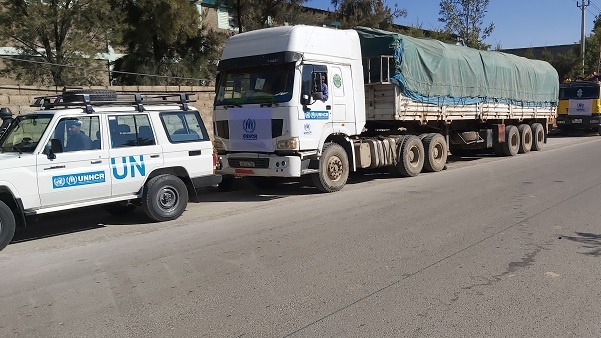
ADDIS ABABA (UNHCR) – The United Nations High Commissioner for Refugees (UNHCR), the UN Refugee Agency, is stepping up assistance to conflict-affected populations in Ethiopia’s northern Tigray, Afar and Amhara regions.
Since the signing of the peace agreement, we have seen a major change on humanitarian access and our ability to move critical assistance into Tigray. As of this week, UNHCR has been able to send 61 trucks into Tigray, carrying 2,400 metric tons of much-needed relief including medicine, shelter materials, blankets and household items, and a tanker carrying 20,000 litres of fuel to help us bring aid to those most in need.
While UNHCR teams had remained in Tigray throughout, operating from Mekelle and Shire, UNHCR has now resumed operations in secondary field locations like in Maichew, Adigrat, and Abi Adi.
Working together with the Ethiopian Government’s Refugees and Returnees Service (RRS) and partners, we have also been able to assist more than 7,000 Eritrean refugees who had been stranded in the Mai Aini and Adi Harush camps in western Tigray. They have been relocated to the recently established Alemwach site in Amhara region, where more than 22,000 Eritrean refugees and asylum-seekers are now living. In Alemwach, people are supported with assistance and essential services.
In Alemwach, one recently relocated refugee I met a week ago told me that he is relieved that his children can finally go back to school again, after more than two years.
Similarly, in Afar, we have also supported the voluntarily relocation of more than 900 Eritrean refugees from various locations including the regional capital Semera back to Barahle camp, which had been caught up in the fighting in January this year. We hope to fully resume services with RRS and partners soon.
But living in safer and more humane conditions is just one step to providing solutions to refugees who have been caught up in vicious cycles of displacement. Conditions for Eritrean refugees in Tigray have been dire throughout much of the conflict. What they need and deserve now is continued and coordinated support from us all so they can rebuild their lives and stand on their own feet, pending durable solutions.
UNHCR is also working closely with local authorities in northern Ethiopia to support Ethiopians displaced by the conflict. Between January and October this year, we have assisted more than 2.1 million internally displaced people – by providing various protection services, shelter and household items – to return to their homes. We have also provided counselling and support to the most vulnerable including separated children and others with specific needs, and survivors of gender-based violence. Over 50,000 internally displaced have been supported to voluntarily return to their homes within Tigray, Afar and Amhara.
While we appreciate these latest developments, there is still a lot more to be done. UNHCR continues to advocate for more conducive conditions in the affected regions, including restoring critical services such as banking and telecommunication, so that we can operate more effectively and efficiently. The recent reconnection of Tigray’s capital Mekelle to the national electricity grid and the resumption of telephone services in Shire are welcome steps.
More regular flights into Tigray and surrounding regions will help us and our partners to reach the most vulnerable so that we can provide much needed assistance, protection and solutions.
We appeal to the international community to continue with its funding support. The door to provide much needed humanitarian assistance is now open; we must get the resources needed to provide it.
Source: UNHCR
